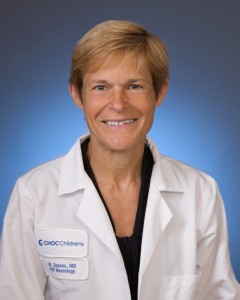
CHOC recently hosted a conference, providing the latest updates on diagnostic tools and treatments for early intervention of epilepsy, concussion management, autism and other common neurologic conditions. The conference, “Neurological Problems Pediatricians Shouldn’t Miss, ” featured CHOC’s pediatric neurologists, including the director of CHOC’s comprehensive epilepsy program — and one of the nation’s leading pediatric epileptologists — Dr. Mary Zupanc. Dr. Zupanc delivered a presentation on “Infantile Spasms and Epilepsy Diagnoses You Shouldn’t Miss.”
Undiagnosed infantile spasms can develop into intractable epilepsy, a very common, but debilitating disorder. Each year, 150,000 children and adolescents in the country will have a single, unprovoked seizure and 33 to 45 percent of these children will develop epilepsy. Infantile spasms are easy to miss for a pediatrician, as they can mimic common symptoms and conditions, such as sleep disturbances, gastroesophageal reflux, startle and shuddering attacks.
The onset for infantile spasm is usually between 4 to 8 months of life, and is characterized by clusters of flexion or extension of upper and lower extremities, occurring for five to 10 seconds every 10 to 20 minutes. Early recognition of this and other epilepsy syndromes is of critical importance in determining a treatment plan. The consequences of intractable epilepsy are multiple and can be very detrimental – including psychosocial and academic effects.
There is a four to six week window of opportunity to treat infantile spasms most successfully. If infantile spasms are suspected, an urgent appointment with a board certified pediatric neurologist is recommended.
In addition, in dealing with intractable epilepsy, treatment can include a drug regimen and epilepsy surgery. Epilepsy surgery should not be considered an avenue of last resort, says Dr. Zupanc.
“Epilepsy surgery is critical, and it is not a last resort,” explains Dr. Zupanc. “Because of the brain’s plasticity in young children, it can recover and adapt much better after surgery than an adult brain. At CHOC, we see a seizure-free outcome success rate of 74 to 90 percent in our pediatric population following surgery. If you hold off on surgery until you’ve tried multiple medications and alternative treatments, you risk long-term cognitive decline, psychosocial problems and sudden, unexpected death.”
She adds, “Children and adults with intractable epilepsy have been shown to be at risk for low self esteem, and more than 50 percent struggle with anxiety and depression. I know surgery sounds scary to families, but our expert team will guide them. It is life-transforming.”




